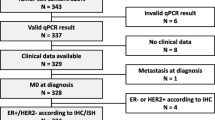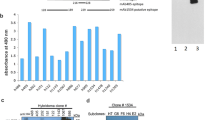Abstract
Introduction
We recently found that DNA methylation of S100A2, spleen tyrosine kinase (SYK), and Stathmin-1 (STMN1) correlates with response to tamoxifen therapy in metastatic breast cancer. In this retrospective study, we investigated immunohistochemically whether these three markers are predictors of relapse in early breast cancer (EBC) patients treated with adjuvant tamoxifen alone.
Methods
Immunohistochemical staining was performed for S100A2, SYK and STMN1 on a tissue microarray containing ER-positive invasive breast carcinomas from a study cohort of 215 operable breast cancer patients, who underwent radical local therapy and who were treated with adjuvant tamoxifen monotherapy. Cox regression was used to correlate staining intensity of the three markers with main endpoints in our study; disease-free survival (DFS), and disease-specific survival (DSS).
Results
In univariate analysis, only STMN1 staining intensity strongly correlated with DFS (P = 0.014) and DSS (P = 0.002). In the groups of low and high STMN1 intensity, DFS was 84% and 63%, and DSS was 89% and 70%. STMN1 retained its prognostic value for DFS (P = 0.002) and DSS (<0.001) in the multivariate model together with lymph node status. We found also a trend to better DFS in patients with low STMN1 intensity in both lymph node-positive (P = 0.001) and -negative patients (P = 0.065). As the tumour cells did not express S100A2 (except in one case) the potential prognostic value of this marker was not evaluated.
Conclusions
Staining intensity of STMN1, but not SYK, predicted outcome in our collective of ER- positive tamoxifen treated EBC patients.






Similar content being viewed by others
References
Early Breast Cancer Trialists’ Collaborative Group (EBCTCG) (2005). Effects of chemotherapy and hormonal therapy for early breast cancer on recurrence and 15-year survival: an overview of the randomized trials. Lancet 365:1687–1716
Egger G, Liang G, Aparicio A, Jones PA (2004). Epigenetics in human disease and prospects for epigenetic therapy. Nature 429:457–463
Esteller M (2005). DNA methylation and cancer therapy: new developments and expectations. Curr Opin Oncol 17:55–60
Baylin SB, Ohm JE (2006). Epigenetic gene silencing in cancer––a mechanism for early oncogenic pathway addiction. Nat Rev Cancer 6:107–116
Martens JWM, Nimmrich I, Koenig T, Look MP, Harbeck N, Model F, Kluth A, Bolt-de Vries J, Sieuwerts AM, Portengen H, Meijer-van Gelder ME, Piepenbrock C, Olek A, Höfler H, Kiechle M, Klijn JGM, Schmitt M, Maier S, Foekens JA (2005). Association of DNA methylation of phosphoserine aminotransferase with response to endocrine therapy in patients with recurrent breast cancer. Cancer Res 65:4101–4107
Maier S, Nimmrich I, Koenig TH, Eppenberger-Castori S, Bohlmann I, Paradiso A, Spyratos F, Jänicke F, Müller V, Thomssen Ch, Höfler H, Nährig J, Eppenberger U, Model F, Martens JWM, Foekens JA, Lesche R, Schwope I, Kluth A, Marx A, Schmitt M, Harbeck N. DNA methylation reliably predicts risk of recurrence in tamoxifen-treated, node-negative breast cancer patients. Eur J Cancer. (Submitted)
Nimmrich I, Maier S, Meijer-Van Gelder ME, Look MP, Harbeck N, Schwope I, Koenig Th, Hartmann O, Kluth A, Model F, Bolt-de Vries J, Sieuwerts AM, Portengen H, Klijn JGM, Schmitt M, Foekens JA, and John W. M. Martens. DNA hypermethylation of PITX2 is a strong marker of poor prognosis in lymph node-negative hormone receptor-positive breast cancer patients. (In preparation)
Widschwendter M, Siegmund KD, Müller HM, Fiegl H, Marth C, Müller-Holzner E, Jones PA, Laird PW (2004) Association of breast cancer DNA methylation profiles with hormone receptor status and response to tamoxifen. Cancer Res 64:3807–3813
Gasparini G, Pozza F, Harris AL (1993) Evaluating the potential usefulness of new prognostic and predictive indicators in node-negative breast cancer patients. J Natl Cancer Inst 85:1206–1219
Cassimeris L (2002) The oncoprotein 18/stathmin family of microtubule destabilizers. Curr Opin Cell Biol 14:18–24
Schafer BW, Heizmann CW (1996) The S100 family of EF-hand calcium-binding proteins: functions and pathology. Trend Biochem Sci 21:134–140
Coopman PJ, Do MT, Barth M, Bowden ET, hayes AJ, Basyuk E, Blancato JK, Vezza PR, McLeskey SW, Mangeat PH, Mueller SC (2000) The Syk tyrosine kinase suppresses malignant growth of human breast cancer cells. Nature 406:742–747
McShane LM, Altman DG, Sauerbrei W, Taube SE, Gion M, Clark GM (2005) Reporting recommendations for tumor marker prognostic studies (REMARK). Nat Clin Pract Oncol 2:416–422
Elston CW, Ellis IO (1991) Pathological prognostic factors in breast cancer. I. The value of histological grade in breast cancer: experience from a large study with long-term follow-up. Histopathology 19:403–410
Perou CM, Sorlie T, Eisen MB, van de Rijn M, Jeffrey SS, Rees CA, Pollack JR, Ross DT, Johnsen H, Akslen LA, Fluge O, Pergamenschikov A, Williams C, Zhu SX, Lonning PE, Borresen-Dale AL, Brown PO, Botstein D (2000) Molecular portraits of human breast tumours. Nature 406:747–752
Yuan Y, Mendez R, Sahin A, Dai JL (2001) Hypermethylation leads to silencing of the SYK gene in human breast cancer. Cancer Res 61:5558–5561
Toyama T, Iwase H, Yamashita H, Hara Y, Omoto Yamashita H, Hara Y, Omoto Y, Suigura H, Zhang Z, Fujii Y (2003) Reduced expression of the Syk gene is correlated with poor prognosis in human breast cancer. 2003 Cancer Lett.189:97–102
Belmont LD, Mitchison TJ (1996) Identification of a protein that interacts with tubulin dimers and increases the catastrophe rate of microtubules. Cell 84:623–631
Curmi C, Curmi PA, Nogues C, Lackhar S, Carelle N, Gopnthier MP, Sobel A, Lidereau R, Bieche I (2000) Overexpression of stathmin in breast carcinomas points out to highly proliferative tumours. Br J Cancer 82:142–150
Brattsand G (2000) Correlation of oncoprotein 18/stathmin expression in human breast cancer with established prognostic factors. Br J Cancer 83:311–318
Paik S, Shak S, Tang G, Kim C, Baker J, Cronin M, Baehner FL, Walker MG, Watson D, Park T, Hiller W, Fisher ER, Wickerham DL, Bryant J, Wolmark N (2004) A multigene assay to predict recurrence of tamoxifen-treated, node-negative breast cancer. N Engl J Med 351:2817–2826
Ma XJ, Wang Z, Ryan PD, Isakoff SJ, Barmettler A, Fuller A, Muir B, Mohapatra G, Salunga R, Tuggle JT, Tran Y, Tran D, Tassin A, Amon P, Wang W, Wang W, Enright E, Stecker K, Estepa-Sabal E, Smith B, Younger J, Balis U, Michaelson J, Bhan A, Habin K, Baer TM, Brugge J, Haber DA, Erlander MG, Sgroi DC (2004) A two-gene expression ratio predicts clinical outcome in breast cancer patients treated with tamoxifen. Cancer Cell 5:607–616
Acknowledgments
This research was supported by the European Union Sixth Framework Programme (LSHC-CT-2003–504586). Conflict of interest statement:Ralf Lesche and Sabine Maier are employees and/or stockholders of Epigenomics AG (Berlin, Germany), a company that aims to commercialize DNA methylation markers, including S100A2, STMN1 and SYK. John Martens, Nadia Harbeck, Manfred Schmitt, Sabine Maier, and John Foekens are inventors of a patent on these DNA methylation markers (WO 2004 035803). This patent has been filed by Epigenomics AG.
Author information
Authors and Affiliations
Corresponding author
Rights and permissions
About this article
Cite this article
Golouh, R., Cufer, T., Sadikov, A. et al. The prognostic value of Stathmin-1, S100A2, and SYK proteins in ER-positive primary breast cancer patients treated with adjuvant tamoxifen monotherapy: an immunohistochemical study. Breast Cancer Res Treat 110, 317–326 (2008). https://doi.org/10.1007/s10549-007-9724-3
Received:
Accepted:
Published:
Issue Date:
DOI: https://doi.org/10.1007/s10549-007-9724-3




